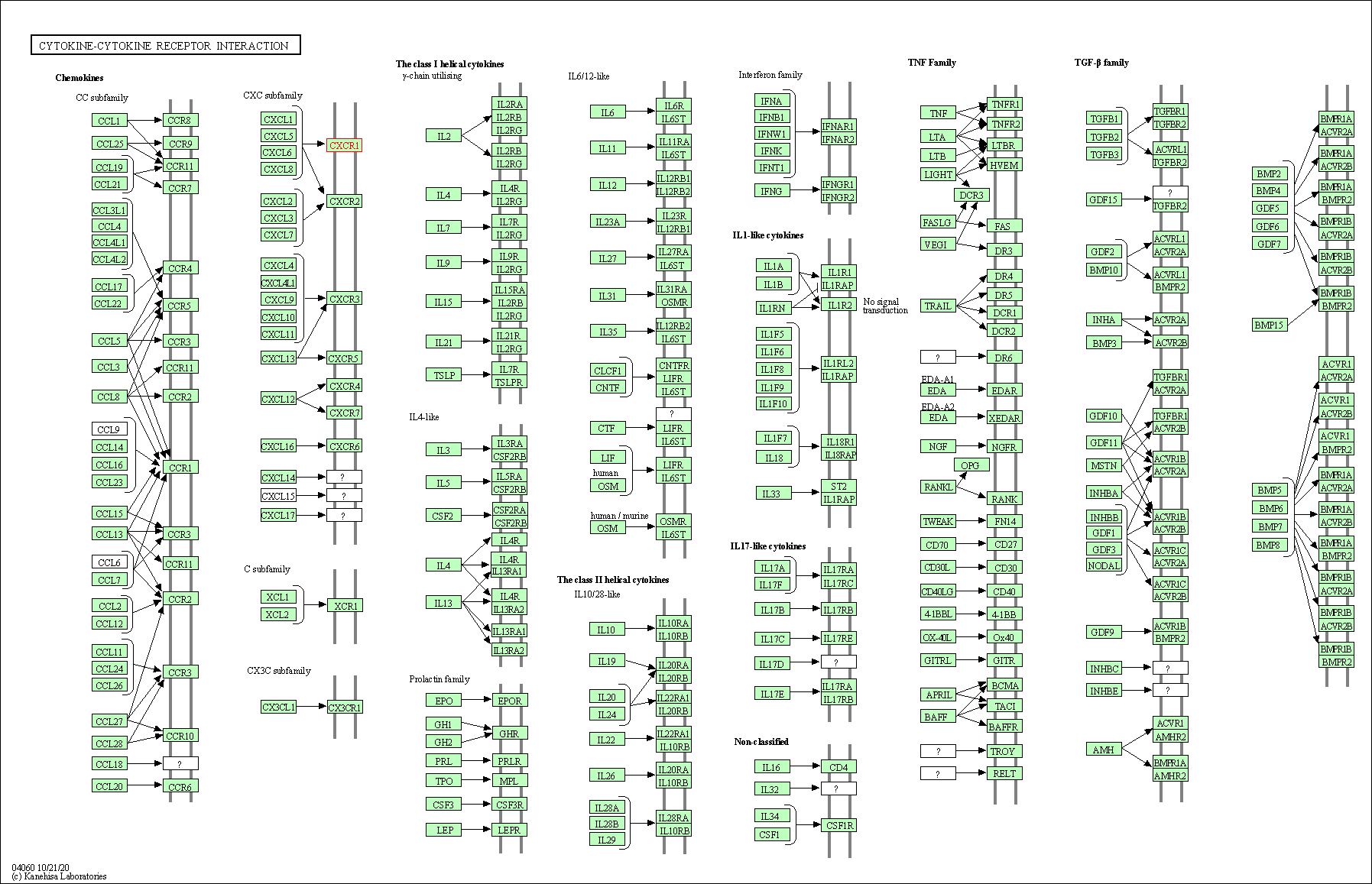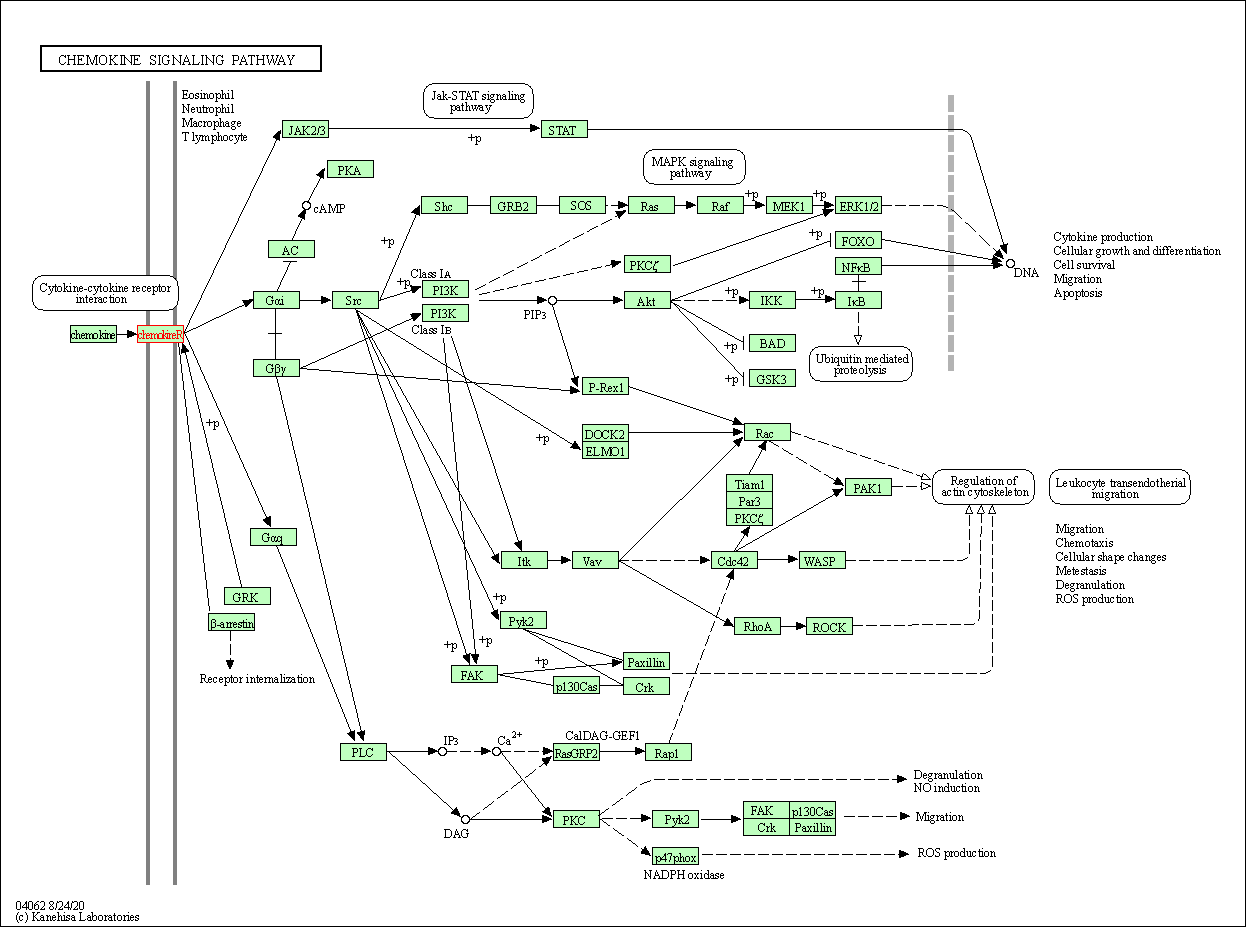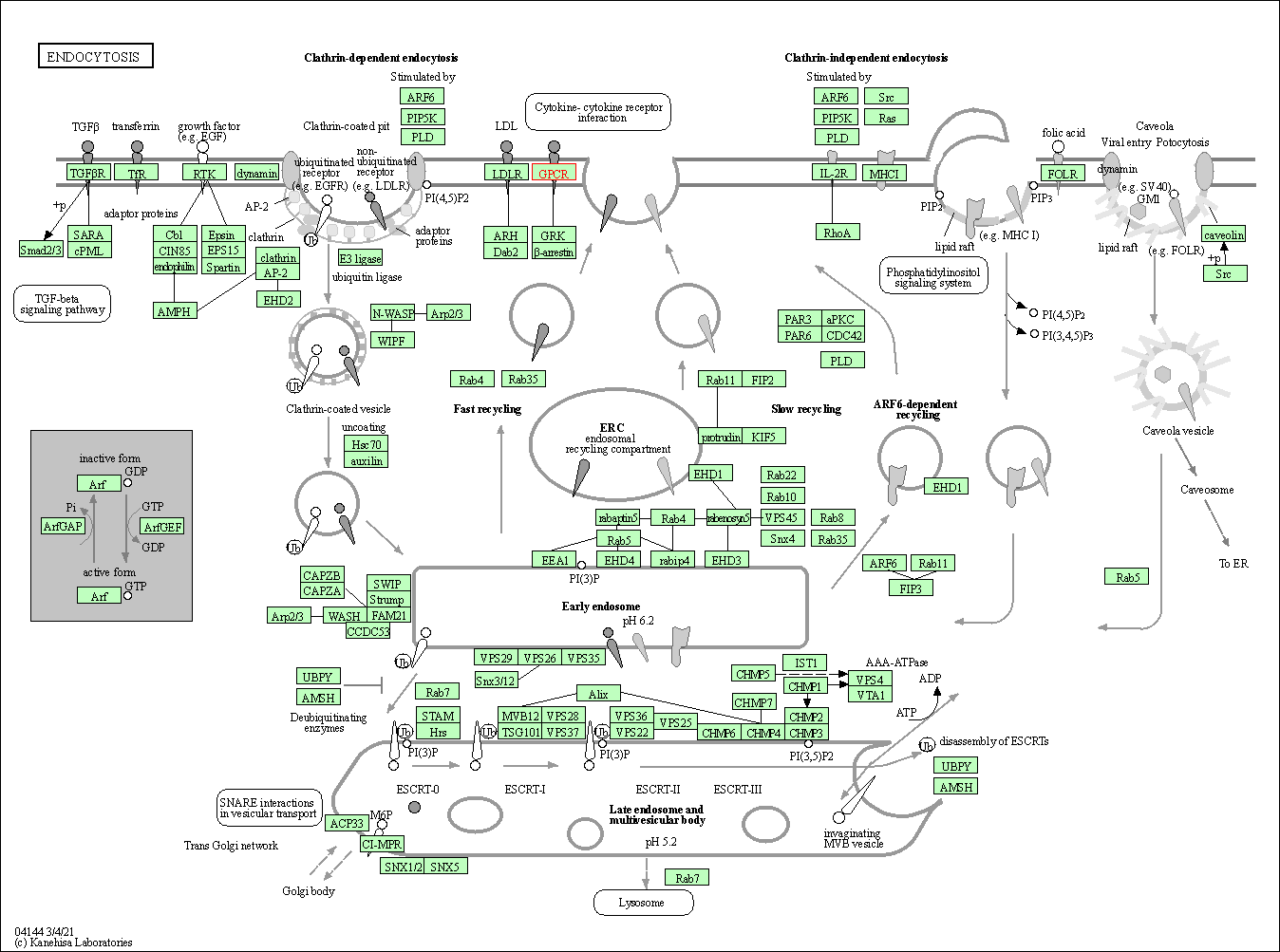Target Information
| Target General Information | Top | |||||
|---|---|---|---|---|---|---|
| Target ID |
T00884
(Former ID: TTDC00190)
|
|||||
| Target Name |
C-X-C chemokine receptor type 1 (CXCR1)
|
|||||
| Synonyms |
Interleukin-8 receptor A; IL8RA; IL-8R A; IL-8 receptor type 1; High affinity interleukin-8 receptor A; CXCR-1; CXC-R1; CMKAR1; CDw128a; CD181
Click to Show/Hide
|
|||||
| Gene Name |
CXCR1
|
|||||
| Target Type |
Successful target
|
[1] | ||||
| Disease | [+] 1 Target-related Diseases | + | ||||
| 1 | Pain [ICD-11: MG30-MG3Z] | |||||
| Function |
Binding of IL-8 to the receptor causes activation of neutrophils. This response is mediated via a G-protein that activate a phosphatidylinositol-calcium second messenger system. This receptor binds to IL-8 with a high affinity and to MGSA (GRO) with a low affinity. Receptor to interleukin-8, which is a powerful neutrophils chemotactic factor.
Click to Show/Hide
|
|||||
| BioChemical Class |
GPCR rhodopsin
|
|||||
| UniProt ID | ||||||
| Sequence |
MSNITDPQMWDFDDLNFTGMPPADEDYSPCMLETETLNKYVVIIAYALVFLLSLLGNSLV
MLVILYSRVGRSVTDVYLLNLALADLLFALTLPIWAASKVNGWIFGTFLCKVVSLLKEVN FYSGILLLACISVDRYLAIVHATRTLTQKRHLVKFVCLGCWGLSMNLSLPFFLFRQAYHP NNSSPVCYEVLGNDTAKWRMVLRILPHTFGFIVPLFVMLFCYGFTLRTLFKAHMGQKHRA MRVIFAVVLIFLLCWLPYNLVLLADTLMRTQVIQESCERRNNIGRALDATEILGFLHSCL NPIIYAFIGQNFRHGFLKILAMHGLVSKEFLARHRVTSYTSSSVNVSSNL Click to Show/Hide
|
|||||
| 3D Structure | Click to Show 3D Structure of This Target | PDB | ||||
| HIT2.0 ID | T70DWW | |||||
| Drugs and Modes of Action | Top | |||||
|---|---|---|---|---|---|---|
| Approved Drug(s) | [+] 1 Approved Drugs | + | ||||
| 1 | Ibuprofen | Drug Info | Approved | Pain | [2], [3] | |
| Clinical Trial Drug(s) | [+] 3 Clinical Trial Drugs | + | ||||
| 1 | Reparixin | Drug Info | Phase 3 | Pancreatic islet transplantation failure | [4] | |
| 2 | SCH-527123 | Drug Info | Phase 2 | Inflammatory bowel disease | [5] | |
| 3 | SX-682 | Drug Info | Phase 1 | Melanoma | [6] | |
| Discontinued Drug(s) | [+] 1 Discontinued Drugs | + | ||||
| 1 | INDOPROFEN | Drug Info | Withdrawn from market | Gout | [7] | |
| Mode of Action | [+] 4 Modes of Action | + | ||||
| Inhibitor | [+] 15 Inhibitor drugs | + | ||||
| 1 | Ibuprofen | Drug Info | [1] | |||
| 2 | SX-682 | Drug Info | [10] | |||
| 3 | INDOPROFEN | Drug Info | [1] | |||
| 4 | R-ketoprofen | Drug Info | [1] | |||
| 5 | (R)-2-(4-Isobutyl-phenyl)-N-methoxy-propionamide | Drug Info | [1] | |||
| 6 | (R)-2-(4-Isobutyl-phenyl)-propionamide | Drug Info | [1] | |||
| 7 | (R)-3-(4-Isobutyl-phenyl)-butan-2-one | Drug Info | [1] | |||
| 8 | (R)-N-Hydroxy-2-(4-isobutyl-phenyl)-propionamide | Drug Info | [1] | |||
| 9 | 1-(2-Bromo-phenyl)-3-(2,4-dihydroxy-phenyl)-urea | Drug Info | [11] | |||
| 10 | 1-(2-hydroxy-4-nitrophenyl)-3-phenylurea | Drug Info | [12] | |||
| 11 | 2-(3-Isobutyl-phenyl)-propionic acid | Drug Info | [1] | |||
| 12 | 2-(3-Isopropyl-phenyl)-propionic acid | Drug Info | [1] | |||
| 13 | 2-[3-(1-Hydroxy-propyl)-phenyl]-propionic acid | Drug Info | [1] | |||
| 14 | 2-[3-(1-Phenyl-ethyl)-phenyl]-propionic acid | Drug Info | [1] | |||
| 15 | 2-[3-(2-Methyl-butyl)-phenyl]-propionic acid | Drug Info | [1] | |||
| Modulator | [+] 1 Modulator drugs | + | ||||
| 1 | Reparixin | Drug Info | [1], [8] | |||
| Antagonist | [+] 1 Antagonist drugs | + | ||||
| 1 | SCH-527123 | Drug Info | [9] | |||
| Agonist | [+] 1 Agonist drugs | + | ||||
| 1 | Il-8((3-73))K11R | Drug Info | [13] | |||
| Cell-based Target Expression Variations | Top | |||||
|---|---|---|---|---|---|---|
| Cell-based Target Expression Variations | ||||||
| Different Human System Profiles of Target | Top |
|---|---|
|
Human Similarity Proteins
of target is determined by comparing the sequence similarity of all human proteins with the target based on BLAST. The similarity proteins for a target are defined as the proteins with E-value < 0.005 and outside the protein families of the target.
A target that has fewer human similarity proteins outside its family is commonly regarded to possess a greater capacity to avoid undesired interactions and thus increase the possibility of finding successful drugs
(Brief Bioinform, 21: 649-662, 2020).
Human Pathway Affiliation
of target is determined by the life-essential pathways provided on KEGG database. The target-affiliated pathways were defined based on the following two criteria (a) the pathways of the studied target should be life-essential for both healthy individuals and patients, and (b) the studied target should occupy an upstream position in the pathways and therefore had the ability to regulate biological function.
Targets involved in a fewer pathways have greater likelihood to be successfully developed, while those associated with more human pathways increase the chance of undesirable interferences with other human processes
(Pharmacol Rev, 58: 259-279, 2006).
Biological Network Descriptors
of target is determined based on a human protein-protein interactions (PPI) network consisting of 9,309 proteins and 52,713 PPIs, which were with a high confidence score of ≥ 0.95 collected from STRING database.
The network properties of targets based on protein-protein interactions (PPIs) have been widely adopted for the assessment of target’s druggability. Proteins with high node degree tend to have a high impact on network function through multiple interactions, while proteins with high betweenness centrality are regarded to be central for communication in interaction networks and regulate the flow of signaling information
(Front Pharmacol, 9, 1245, 2018;
Curr Opin Struct Biol. 44:134-142, 2017).
Human Similarity Proteins
Human Pathway Affiliation
Biological Network Descriptors
|
|
| Protein Name | Pfam ID | Percentage of Identity (%) | E value |
|---|---|---|---|
| Olfactory receptor 2T4 (OR2T4) | 24.419 (42/172) | 3.00E-03 |





| KEGG Pathway | Pathway ID | Affiliated Target | Pathway Map |
|---|---|---|---|
| Cytokine-cytokine receptor interaction | hsa04060 | Affiliated Target |

|
| Class: Environmental Information Processing => Signaling molecules and interaction | Pathway Hierarchy | ||
| Viral protein interaction with cytokine and cytokine receptor | hsa04061 | Affiliated Target |

|
| Class: Environmental Information Processing => Signaling molecules and interaction | Pathway Hierarchy | ||
| Chemokine signaling pathway | hsa04062 | Affiliated Target |

|
| Class: Organismal Systems => Immune system | Pathway Hierarchy | ||
| Phospholipase D signaling pathway | hsa04072 | Affiliated Target |

|
| Class: Environmental Information Processing => Signal transduction | Pathway Hierarchy | ||
| Endocytosis | hsa04144 | Affiliated Target |

|
| Class: Cellular Processes => Transport and catabolism | Pathway Hierarchy | ||
| Degree | 7 | Degree centrality | 7.52E-04 | Betweenness centrality | 8.44E-05 |
|---|---|---|---|---|---|
| Closeness centrality | 1.98E-01 | Radiality | 1.34E+01 | Clustering coefficient | 4.76E-02 |
| Neighborhood connectivity | 1.26E+01 | Topological coefficient | 2.47E-01 | Eccentricity | 12 |
| Download | Click to Download the Full PPI Network of This Target | ||||
| Chemical Structure based Activity Landscape of Target | Top |
|---|---|
| Drug Property Profile of Target | Top | |
|---|---|---|
| (1) Molecular Weight (mw) based Drug Clustering | (2) Octanol/Water Partition Coefficient (xlogp) based Drug Clustering | |
|
|
||
| (3) Hydrogen Bond Donor Count (hbonddonor) based Drug Clustering | (4) Hydrogen Bond Acceptor Count (hbondacc) based Drug Clustering | |
|
|
||
| (5) Rotatable Bond Count (rotbonds) based Drug Clustering | (6) Topological Polar Surface Area (polararea) based Drug Clustering | |
|
|
||
| "RO5" indicates the cutoff set by lipinski's rule of five; "D123AB" colored in GREEN denotes the no violation of any cutoff in lipinski's rule of five; "D123AB" colored in PURPLE refers to the violation of only one cutoff in lipinski's rule of five; "D123AB" colored in BLACK represents the violation of more than one cutoffs in lipinski's rule of five | ||
| Co-Targets | Top | |||||
|---|---|---|---|---|---|---|
| Co-Targets | ||||||
| Target Poor or Non Binders | Top | |||||
|---|---|---|---|---|---|---|
| Target Poor or Non Binders | ||||||
| Target Profiles in Patients | Top | |||||
|---|---|---|---|---|---|---|
| Target Expression Profile (TEP) |
||||||
| Target Affiliated Biological Pathways | Top | |||||
|---|---|---|---|---|---|---|
| KEGG Pathway | [+] 4 KEGG Pathways | + | ||||
| 1 | Cytokine-cytokine receptor interaction | |||||
| 2 | Chemokine signaling pathway | |||||
| 3 | Endocytosis | |||||
| 4 | Epithelial cell signaling in Helicobacter pylori infection | |||||
| NetPath Pathway | [+] 1 NetPath Pathways | + | ||||
| 1 | IL2 Signaling Pathway | |||||
| Panther Pathway | [+] 2 Panther Pathways | + | ||||
| 1 | Inflammation mediated by chemokine and cytokine signaling pathway | |||||
| 2 | Interleukin signaling pathway | |||||
| PID Pathway | [+] 1 PID Pathways | + | ||||
| 1 | IL8- and CXCR1-mediated signaling events | |||||
| Reactome | [+] 2 Reactome Pathways | + | ||||
| 1 | Chemokine receptors bind chemokines | |||||
| 2 | G alpha (i) signalling events | |||||
| WikiPathways | [+] 6 WikiPathways | + | ||||
| 1 | GPCRs, Class A Rhodopsin-like | |||||
| 2 | Differentiation Pathway | |||||
| 3 | Peptide GPCRs | |||||
| 4 | GPCR ligand binding | |||||
| 5 | GPCR downstream signaling | |||||
| 6 | GPCRs, Other | |||||
| Target-Related Models and Studies | Top | |||||
|---|---|---|---|---|---|---|
| Target Validation | ||||||
| References | Top | |||||
|---|---|---|---|---|---|---|
| REF 1 | 2-Arylpropionic CXC chemokine receptor 1 (CXCR1) ligands as novel noncompetitive CXCL8 inhibitors. J Med Chem. 2005 Jun 30;48(13):4312-31. | |||||
| REF 2 | URL: http://www.guidetopharmacology.org Nucleic Acids Res. 2015 Oct 12. pii: gkv1037. The IUPHAR/BPS Guide to PHARMACOLOGY in 2016: towards curated quantitative interactions between 1300 protein targets and 6000 ligands. (Ligand id: 2713). | |||||
| REF 3 | New drugs in development for the treatment of endometriosis. Expert Opin Investig Drugs. 2008 Aug;17(8):1187-202. | |||||
| REF 4 | Clinical pipeline report, company report or official report of the Pharmaceutical Research and Manufacturers of America (PhRMA) | |||||
| REF 5 | Emerging drugs to treat Crohn's disease. Expert Opin Emerg Drugs. 2007 Mar;12(1):49-59. | |||||
| REF 6 | ClinicalTrials.gov (NCT03161431) SX-682 Treatment in Subjects With Metastatic Melanoma Concurrently Treated With Pembrolizumab. U.S. National Institutes of Health. | |||||
| REF 7 | Drugs@FDA. U.S. Food and Drug Administration. U.S. Department of Health & Human Services. 2015 | |||||
| REF 8 | Reparixin, an inhibitor of CXCR1 and CXCR2 receptor activation, attenuates blood pressure and hypertension-related mediators expression in spontane... Biol Pharm Bull. 2011;34(1):120-7. | |||||
| REF 9 | Clinical pipeline report, company report or official report of the Pharmaceutical Research and Manufacturers of America (PhRMA) | |||||
| REF 10 | Inhibition of MDSC Trafficking with SX-682, a CXCR1/2 Inhibitor, Enhances NK-Cell Immunotherapy in Head and Neck Cancer Models. Clin Cancer Res. 2020 Mar 15;26(6):1420-1431. | |||||
| REF 11 | Synthesis and structure-activity relationships of 3,5-diarylisoxazoles and 3,5-diaryl-1,2,4-oxadiazoles, novel classes of small molecule interleuki... Bioorg Med Chem Lett. 2004 Aug 16;14(16):4307-11. | |||||
| REF 12 | Evaluation of potent and selective small-molecule antagonists for the CXCR2 chemokine receptor. J Med Chem. 2004 Mar 11;47(6):1319-21. | |||||
| REF 13 | Il-8((3-73))K11R is a high affinity agonist of the neutrophil CXCR1 and CXCR2. Biochem Biophys Res Commun. 2001 Aug 24;286(3):595-600. | |||||
If You Find Any Error in Data or Bug in Web Service, Please Kindly Report It to Dr. Zhou and Dr. Zhang.

